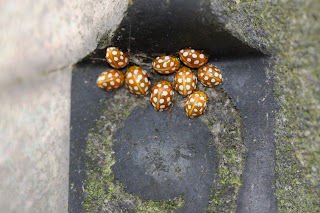Happy New Year to all. May 2022 bring you health, nature experiences and happiness.
And some
Joni Mitchell lyrics as we enter 2022 for North Tyneside Council
They took all the trees
Put 'em in a tree museum
Then they charged the people
A dollar and a half just to see 'em
Don't it always seem to go
That you don't know what you've got 'til it's
gone?
They paved paradise
Put up a parking lot
It has long
been my custom to take a walk on patch on New Year’s Day whatever the weather
conditions. Over the past eleven years
it has been with Sam, barring one year when he was unable to rise from bed
having had a touch too much to drink on New Year’s Eve which had left him newt
like. Our walk is never aimed at amassing
a large list of bird species, after all there are another 364 days in the year
to catch sight of birds. Our intention
has always been just to enjoy a few hours on patch and to take what comes. Folk often ask us during the walk if we have
been anywhere else prior to them speaking and or where we are off to next. The answer is always the same, we have not
been anywhere else and we do not intend to travel anywhere else today. Despite North Tyneside Councils best
attempts there is still a patch left for us to enjoy and we make the most of it
while we can. More and more building
works are lined up for the future and you just never know what green space is
going to disappear next. Sadly quite a
few trees have already disappeared following the recent storms.
Everyone we
bump into are usually courteous and talkative on New Year’s Day, they have the
rest of the year to be miserable if they so wish. Today’s elevated temperatures made it feel
like spring had arrived. My first bird
of the year was a Robin singing in the garden before chasing after
another. Early courtship I believe. After Sam had become my first foot for
2022 we set off. A Mistle Thrush
sang from the top of the trees but this storm cock did not bring a storm. In fact, the clouds soon broke to eventually
bring blue skies. The calls of Pink-footed
Geese were heard before we saw the skein fly overhead and a Nuthatch
continually called.
The village
and it surrounds were noticeably quiet
but we managed to pick out a few interesting plants whilst listening to the Wrens
and catching sight of Bullfinches and a party of Long tailed Tits. A Kestrel was seen in the area on two
occasions. Kestrels used to be commonly
seen in the centre of our patch years ago when there was spare waste
ground. Nowadays your much more likely
to find Sparrowhawks here and the Kestrel, much diminished in numbers
throughout the country, is usually only found on the outer fringes of the patch Early last year we had found a number of
hibernating Orange Ladybirds and then in the late autumn had found numerous Harlequin
Ladybirds along with the Orange Ladybirds (I’ll save that find for a separate
blog). Today we found them again and we
believe this area likely holds hundreds of these species. We initially found two Harlequins woken from
hibernation, no doubt by the unusually warm conditions. Such conditions accounted for a lack of birds
that we would have normally expected.
The smaller
lake held 10+ Gadwall, a species never seen on the lake just a few years
ago, but now a regular. Mallard,
Tufted Duck and Coot were also here.
We soon found a Little Grebe on the larger lake. Other birds here included Mallard,
Goosander, Tufted Duck, Pochard Goldeneye, Moorhen, Canada Geese and
a small number of Mute Swans.
Gulls seen were Black Headed, Common, Herring and Great Black
Backed.
A Pied
Wagtail was seen near a dying Mute Swan which by the time we reached
it was in fact dead and been pecked at by a gull. It seems likely that it was a victim of avian
influenza which is affecting the country to a high degree. The dead bird was carefully bagged taken away
by a lady in protective clothing and face covering. A young Swan nearby was behaving very
strangely and we would not be surprised if this too succumbs. There have been a number of dead swans on the
lake recently and this is probably explained in the main by avian influenza and
why there are so few Mute Swans remaining.
Sam picked
up the call of a Siskin feeding in the Alder and we spotted it as it
flew off over the lake.
We retraced our steps and returned to the village area and onwards to home. It was still very warm, the sun was shinning and the sky was clear blue. Would I have given up this enjoyable nature walk to tear around Northumberland amassing a grand list? The answer is a definite no.
I am not one for New Year’s Resolutions but I do set myself projects. In 2021 it was to read as many works as possible by John Le Carre and non-fiction writer Ben Macintyre. Their works have nothing to do with nature I know, but I enjoy secret agent stories. I did quite well. I have decided that the project for 2022 is to read as much as possible about Northeast Natural History, and Local History of my immediate surroundings. Oh yes, and to get more exercise. I’ve started well as I have just come back from a 2 hour walk on path again today, the 2nd of January. My list of birds yesterday was a mere thirty-nine, but a very enjoyable thirty-nine along with nature in general and some good chat with passing folk.







No comments:
Post a Comment